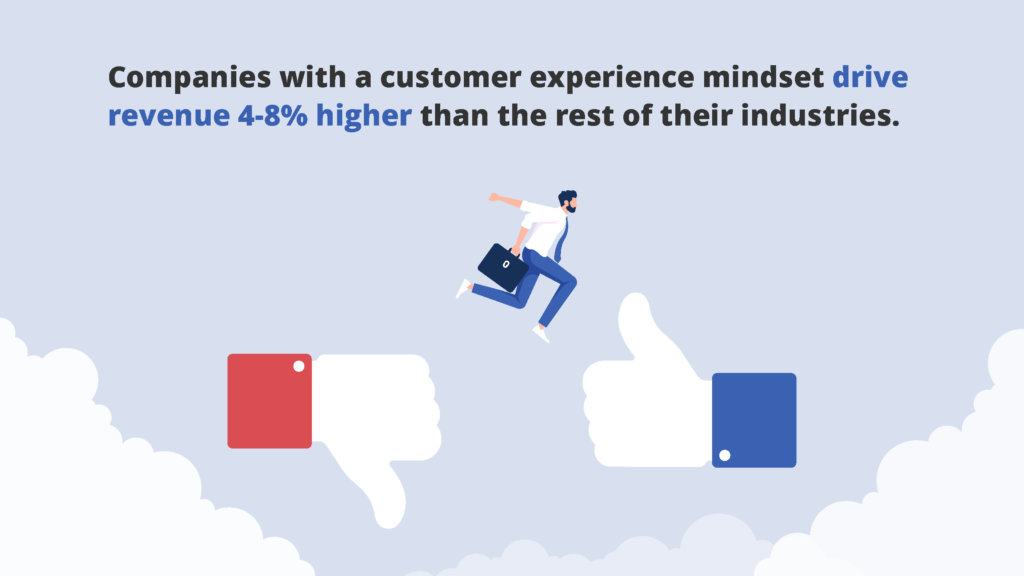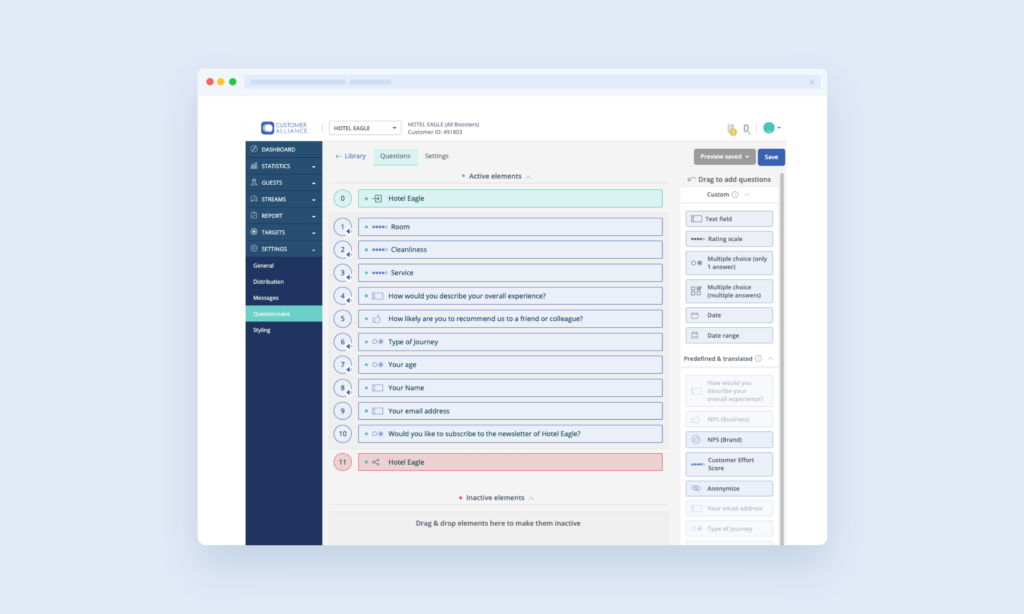If you want to know how to increase revenue, you’ll need to improve the customer experience. Companies with a customer experience mindset drive revenue 4-8% higher than the rest of their industries (1). Why? They listen to the Voice of the Customer. They ask customers for feedback, and continually perform and act on a customer experience analysis.
Why collecting feedback makes businesses successful
When you ask customers their opinions about your product or service, it shows them that you care. Did you know that 77% of customers view companies more favourably if they ask for and apply customer feedback (2)?
When you care about the customer experience, you not only show your customers you care, you understand how to better meet their needs.

You can use consumer feedback to collect valuable insights on your product, brand, and customers from their feedback. You can perform a customer satisfaction analysis by including a customer satisfaction metric like a customer effort score, customer loyalty index, a CSAT, or NPS question. (We’ll get into this more below.)
Lastly, the more public customer feedback you have, the greater trust you build in your company. We’re talking about full Online Reputation Management to deliver your business’ social proof.
This means,
- You have authentic customer reviews on major review sites like Google, Yelp, Trustpilot, and more per industry.
- You have customer reviews directly on your website to drive conversion.
For further proof, we offer 8 more reasons to invest in feedback in our guide Feedback Economy 101.
How to use feedback to drive revenue
[ca-form id=”194451″ align=”left” var1=”https://www.customer-alliance.com/wp-content/uploads/2021/08/customer-alliance-revenue-through-feedback-guide-download.pdf”]Before you launch your customer feedback initiative, establish your goal(s). What do you want to learn about?—A specific touchpoint? Company perception? Product usability? Customer loyalty index? We could go on, but the point is, you need to define learning objectives.
Invest in a feedback software
As customer feedback continues to rise as a competitive advantage, both Enterprise and SMB-sized companies are seeking out software to help them collect, analyse, and distribute customer feedback. These platforms are key to sifting through large amounts of unstructured data from consumers and making sense of it by providing objective results from their analytics.
Determine your metrics
Related to your goals above, decide which metrics you wish to use to help you monitor your performance.
- NPS question (NPS): What does NPS stand for? Net promoter score. The NPS calculator monitors customer loyalty over time.
- Customer Loyalty Index (CLI): The Customer Loyalty Index can be viewed NPS+ as it includes the NPS question plus two more questions about repeat purchases and multiple purchases.
- Customer Effort Score (CES): The Customer Effort Score measures how difficult a task is for a customer to complete. The Customer Effort Score metric is great for example, measuring the product usability of a minimal viable product.
- Customer Satisfaction Score (CSAT): This score provides a customer satisfaction analysis of a specific touchpoint (as opposed to over time like NPS).
We cover the above metrics in-depth here: How to measure customer satisfaction KPI: NPS, CSAT, and CES. In this article, we also discuss the best NPS questions, NSP surveyors, and what to do with your NPS survey results.
Ask for feedback
#1 Create your customer surveys
We recommend you include one of the above metric questions plus 2-3 follow-up questions. For those wanting a customer satisfaction analysis, check out how to create a successful customer satisfaction survey.
We also recommend creating a public feedback survey asking customers to leave your company reviews on important review sites to grow your online presence. There are many survey solutions out there that will help you create, automate, and analyse your surveys.
#2 Decide when to ask
Depending on your survey type, you’ll need to decide when you want to ask for feedback. If you’re measuring customer loyalty over time, it’s helpful to check in on a regular basis. For example every 3 to 6 months.
Or, if you want to know how a specific touchpoint is performing, you can ask about difficulty (CES) or satisfaction (CSAT) right after the customer has engaged in this touchpoint.

#3 Determine sharing channels
Know your audience. Do they prefer email, text, or providing feedback onsite? Today there are many ways to share a customer survey. Consider web chat, a form on your website, email, text, in-store tablets, or QR codes.
The important thing is that you make it convenient for them. And certainly, the channels might be different for different customer segments. Don’t be afraid to employ 2-3 channels.
Analyse feedback
Once you have your surveys in place, regularly review the customer data gleaned from them. They will greatly contribute to your customer experience analysis. Which touchpoints need improvement? Are customers not getting enough information, if not the correct information? How do they feel about your brand as a whole? Will they remain loyal?
Now, if you have a Voice of the Customer platform, you’ll have access to semantic analytics telling you your customers’ emotions about a particular topic for both surveys and reviews. You can track survey results, and also daily monitor the metrics mentioned above and apply proper benchmarks throughout your company.
Act on their opinions
Engage in customer feedback.
Whether it’s a public review, social media, or a private response to a survey, take the time to respond. When it’s a great feedback, thank them. If a customer needs help, act fast to fix their issue. When a customer provides negative feedback, learn from it. Then act on it and let them know how you’ve changed for the better based on their feedback.
Show off your hard work
We’re not saying investing in customer feedback is without effort, we’re saying it’s well worth it. So, once you start putting in the work, celebrate and share your results. Send reviews to major review sites, and display great reviews on your website to show the world you care about your customers’ opinions.
Consider sending a quarterly newsletter letting customers know how you’ve updated your offerings based on their feedback. Share great feedback with your employees to serve as further motivation.
In conclusion, establish a public and internal feedback culture. You’ll not only drive spirits, but you’ll also drive revenue.
Sources:
